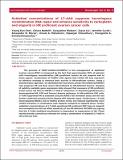| dc.contributor.author | Choi, Young Eun | en_US |
| dc.contributor.author | Battelli, Chiara | en_US |
| dc.contributor.author | Watson, Jacqueline | en_US |
| dc.contributor.author | Liu, Joyce | en_US |
| dc.contributor.author | Curtis, Jennifer | en_US |
| dc.contributor.author | Morse, Alexander N. | en_US |
| dc.contributor.author | Matulonis, Ursula A. | en_US |
| dc.contributor.author | Chowdhury, Dipanjan | en_US |
| dc.contributor.author | Konstantinopoulos, Panagiotis A. | en_US |
| dc.date.accessioned | 2014-07-07T17:03:34Z | |
| dc.date.issued | 2014 | en_US |
| dc.identifier.citation | Choi, Young Eun, Chiara Battelli, Jacqueline Watson, Joyce Liu, Jennifer Curtis, Alexander N. Morse, Ursula A. Matulonis, Dipanjan Chowdhury, and Panagiotis A. Konstantinopoulos. 2014. “Sublethal concentrations of 17-AAG suppress homologous recombination DNA repair and enhance sensitivity to carboplatin and olaparib in HR proficient ovarian cancer cells.” Oncotarget 5 (9): 2678-2687. | en |
| dc.identifier.issn | 1949-2553 | en |
| dc.identifier.uri | http://nrs.harvard.edu/urn-3:HUL.InstRepos:12406708 | |
| dc.description.abstract | The promise of PARP-inhibitors(PARPis) in the management of epithelial ovarian cancer(EOC) is tempered by the fact that approximately 50% of patients with homologous recombination (HR)-proficient tumors do not respond well to these agents. Combination of PARPis with agents that inhibit HR may represent an effective strategy to enhance their activity in HR-proficient tumors. Using a bioinformatics approach, we identified that heat shock protein 90 inhibitors(HSP90i) may suppress HR and thus revert HR-proficient to HR-deficient tumors. Analysis of publicly available gene expression data showed that exposure of HR-proficient breast cancer cell lines to HSP90i 17-AAG(17-allylamino-17-demethoxygeldanamycin) downregulated HR, ATM and Fanconi Anemia pathways. In HR-proficient EOC cells, 17-AAG suppressed HR as assessed using the RAD51 foci formation assay and this was further confirmed using the Direct Repeat-GFP reporter assay. Furthermore, 17-AAG downregulated BRCA1 and/or RAD51 protein levels, and induced significantly more γH2AX activation in combination with olaparib compared to olaparib alone. Finally, sublethal concentrations of 17-AAG sensitized HR-proficient EOC lines to olaparib and carboplatin but did not affect sensitivity of the HR-deficient OVCAR8 line arguing that the 17-AAG mediated sensitization is dependent on suppression of HR. These results provide a preclinical rationale for using a combination of olaparib/17-AAG in HR-proficient EOC. | en |
| dc.language.iso | en_US | en |
| dc.publisher | Impact Journals LLC | en |
| dc.relation.hasversion | http://www.ncbi.nlm.nih.gov/pmc/articles/PMC4058036/pdf/ | en |
| dash.license | LAA | en_US |
| dc.subject | Epithelial ovarian cancer | en |
| dc.subject | platinum | en |
| dc.subject | PARP inhibitors | en |
| dc.subject | Heat Shock Protein 90 inhibitors | en |
| dc.subject | homologous recombination | en |
| dc.title | Sublethal concentrations of 17-AAG suppress homologous recombination DNA repair and enhance sensitivity to carboplatin and olaparib in HR proficient ovarian cancer cells | en |
| dc.type | Journal Article | en_US |
| dc.description.version | Version of Record | en |
| dc.relation.journal | Oncotarget | en |
| dash.depositing.author | Matulonis, Ursula A. | en_US |
| dc.date.available | 2014-07-07T17:03:34Z | |
| dc.identifier.doi | 10.18632/oncotarget.1929 | |
| dash.contributor.affiliated | Konstantinopoulos, Panagiotis | |
| dash.contributor.affiliated | Chowdhury, Dipanjan | |
| dash.contributor.affiliated | Matulonis, Ursula | |


